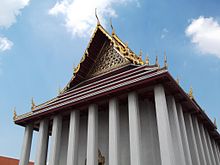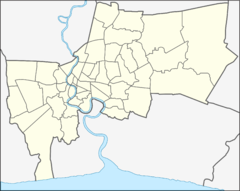Wat Saket
| Wat Saket Ratcha Wora Maha Wihan | |
|---|---|
 | |
| Religion | |
| Affiliation | Buddhism |
| Location | |
| Country | Thailand |
| Geographic coordinates | 13°45′14″N 100°30′29″E / 13.753864°N 100.508097°E |

Wat Saket Ratcha Wora Maha Wihan (Template:Lang-th, usually shortened to Wat Saket (RTGS: Wat Sa Ket) is a Buddhist temple (wat) in Pom Prap Sattru Phai district, Bangkok, Thailand.
The temple dates back to the Ayutthaya era, when it was known as Wat Sakae. When Bangkok became the capital, King Rama I renovated the temple and gave it its present name.
Phu Khao Thong
Phu Khao Thong (“Golden Mountain”, ภูเขาทอง) is a steep artificial hill inside the Wat Saket compound.
Rama I's grandson, King Rama III (1787–1851), decided to build a chedi of huge dimensions inside Wat Saket, but the chedi collapsed during construction because the soft soil of Bangkok could not support the weight. Over the next few decades, the abandoned mud-and-brick structure acquired the shape of a natural hill and was overgrown with weeds. The locals called it the phu khao (ภูเขา), as if it were a natural feature.[1]
During the reign of King Rama IV, construction began of a small chedi on the hill. It was completed early in the reign of his son, King Rama V (1853–1910). A relic of the Buddha was brought from Sri Lanka and placed in the chedi.[2] The surrounding concrete walls were added in the 1940s to stop the hill from eroding.[3] The modern Wat Saket was built in the early 20th century of Carrara marble.[4]
An annual festival is held at Wat Saket every November, featuring a candlelight procession up Phu Khao Thong to the chedi.[5]
Phu Khao Thong is now a popular Bangkok tourist attraction and has become a symbol of the city.

See also
Notes
- ^ Old photo (around 1900) of dilapidated prang from the collection of Cornell University Library (last access 2009-09-24).
- ^ McDaniel, Justin Thomas (2011). The Lovelorn Ghost and the Magical Monk: Practicing Buddhism in Modern Thailand. ISBN 9780231527545.
- ^ Wikimapia: Temple of the Golden Mount or Phu Khao Thong (ภูเขาทอง) -Bangkok (Krungthep)
- ^ Norwich 2001, p. 266
- ^ Emmons 2008, p. 64
References
- Norwich, John Julius (2001), Great architecture of the world, USA: De Capo Press Inc., ISBN 0-306-81042-5
External links
13°45′14″N 100°30′24″E / 13.75389°N 100.50667°E
- ^ Piemmettawat, Paisarn (2015). Siam Through the Lens of John Thompson 1865-66 (1 ed.). River Books Press Ltd. p. 109. ISBN 9786167339511.

